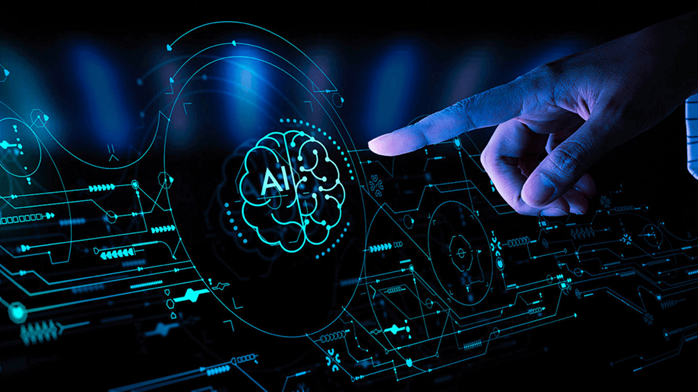What Role Does Artificial Intelligence Play in Cybersecurity?

The rapid evolution of technology has brought about numerous benefits, but it has also introduced new challenges, particularly in the realm of cybersecurity. As the digital landscape expands, so too do the threats targeting sensitive data, networks, and systems. Traditional methods of cybersecurity, while effective to some extent, are often inadequate in handling the volume and complexity of modern threats. This is where Artificial Intelligence (AI) comes into play.
Artificial Intelligence has emerged as a transformative force in cybersecurity, offering innovative solutions to detect, prevent, and respond to cyberattacks more efficiently and effectively than ever before. AI’s ability to analyze large datasets, recognize patterns, and adapt to new information in real-time has made it a powerful ally in the fight against cybercriminals.
In this article, we will explore the role that AI plays in cybersecurity, the benefits it provides, and how it is reshaping the future of digital security.
The Growing Threat Landscape
Before diving into the specifics of AI’s role in cybersecurity, it’s important to understand the evolving nature of cyber threats. Hackers and cybercriminals are becoming increasingly sophisticated, employing advanced techniques like machine learning, social engineering, and automated attacks to breach systems.
According to a report by Cybersecurity Ventures, cybercrime is projected to cost the world $10.5 trillion annually by 2025. This stark statistic highlights the urgency with which organizations must adapt to the growing threats in cyberspace. The sheer volume and speed at which cyberattacks are happening make it increasingly difficult for traditional security measures to keep up.
This is where AI proves to be a game-changer. AI and machine learning algorithms can analyze vast amounts of data quickly and accurately, enabling them to identify threats in real time and respond proactively.
How AI Enhances Cybersecurity
AI plays several crucial roles in enhancing cybersecurity across various sectors. From threat detection to incident response and vulnerability management, AI offers numerous benefits that improve the overall security posture of organizations. Here’s a closer look at the key ways AI is reshaping cybersecurity:
1. Threat Detection and Prevention
One of the most significant contributions of AI to cybersecurity is its ability to detect and prevent cyberattacks. Traditional security measures, such as firewalls and antivirus software, rely on predefined signatures and rules to identify malicious activities. While these methods are effective for known threats, they often fail to detect new, unknown attacks (zero-day vulnerabilities).
AI-powered systems, on the other hand, use machine learning algorithms to analyze patterns in network traffic and user behavior. By establishing a baseline of “normal” activity, these systems can identify anomalies and flag potentially malicious behavior in real time. For example, AI can detect unusual login attempts, abnormal file transfers, or unauthorized access to sensitive information that would be difficult for traditional security tools to identify.
2. Automated Incident Response
In addition to detecting threats, AI can also automate the response to cyber incidents. When a potential attack is identified, AI-driven systems can take immediate action to mitigate the threat. This could involve isolating affected systems, blocking malicious IP addresses, or quarantining compromised files, all without human intervention.
Automating incident response is crucial in minimizing the impact of cyberattacks, as it allows for a faster and more coordinated reaction. In the event of a data breach or ransomware attack, for instance, AI systems can quickly identify the source of the breach and prevent further damage while cybersecurity teams focus on investigating the attack and restoring operations.
3. Predictive Threat Intelligence
AI also plays a key role in predictive threat intelligence. By continuously analyzing large volumes of data from a variety of sources, AI systems can identify emerging threats and predict potential attack vectors before they occur. This allows organizations to stay one step ahead of cybercriminals and take proactive measures to secure their systems.
AI-powered threat intelligence platforms can scan data from news sources, social media, and the dark web to identify emerging vulnerabilities, zero-day exploits, and new attack trends. By leveraging AI for predictive analytics, organizations can gain valuable insights into the evolving threat landscape and make informed decisions about their security strategies.
4. Advanced Malware Detection
Malware is one of the most common forms of cyberattack, and it is becoming increasingly sophisticated. AI is capable of detecting both known and unknown types of malware by analyzing patterns in system behavior, rather than relying solely on virus signatures.
Machine learning algorithms can identify suspicious behavior such as unusual file modifications, system performance slowdowns, or abnormal communication with external servers. AI can then flag this activity as potentially malicious, even if the malware is previously unknown. This approach enables quicker detection of malware, often preventing it from causing widespread damage.
5. Vulnerability Management
AI is also instrumental in identifying and managing system vulnerabilities. Traditional vulnerability scanning tools can be time-consuming and may miss critical weaknesses in the system. AI-based tools can automate the scanning process and identify vulnerabilities in real-time, providing organizations with actionable insights into where their systems are most at risk.
Moreover, AI can help prioritize vulnerabilities based on their potential impact and exploitability, allowing organizations to focus on fixing the most critical issues first. This prioritization can significantly improve the efficiency of vulnerability management programs and help organizations reduce their overall risk exposure.
6. Behavioral Analytics
Behavioral analytics is another area where AI excels. AI-driven systems use machine learning algorithms to analyze user and network behavior, detecting patterns that could indicate insider threats or compromised accounts. For instance, if an employee begins accessing data they typically wouldn’t, or if their account shows signs of unusual activity, AI systems can flag these deviations as potential security risks.
Behavioral analytics can help detect threats that don’t fit the typical attack patterns, such as insider attacks, social engineering, and credential stuffing. By monitoring user behavior continuously, AI systems provide an additional layer of protection against malicious actions that would otherwise go unnoticed.
7. Enhanced Authentication Methods
AI is revolutionizing authentication methods, making them more secure and user-friendly. Traditional passwords are increasingly vulnerable to cyberattacks, leading to the adoption of more advanced authentication methods such as biometric recognition (face, fingerprint, and voice recognition) and multi-factor authentication (MFA).
AI plays a crucial role in enhancing biometric security by analyzing data patterns to verify the identity of individuals. For example, AI-powered facial recognition systems can identify a person based on unique facial features, making it more difficult for attackers to gain unauthorized access. Similarly, AI is used in behavioral biometrics, analyzing patterns such as keystroke dynamics, mouse movements, and device usage to verify a user’s identity.
Benefits of AI in Cybersecurity
The integration of AI into cybersecurity offers several benefits for organizations, both large and small:
- Speed and Efficiency: AI can process large volumes of data much faster than human analysts, allowing for quicker identification and response to potential threats.
- Scalability: As organizations grow and the number of devices connected to their networks increases, AI systems can scale easily to handle the increased volume of data and threats.
- Reduced Human Error: AI can automate many tasks traditionally handled by humans, reducing the potential for human error and ensuring more accurate threat detection and response.
- Cost Savings: By automating repetitive tasks and improving efficiency, AI can help reduce the need for large cybersecurity teams, resulting in cost savings for organizations.
- Continuous Learning: AI systems continuously learn and adapt to new threats, becoming more effective over time as they gain experience from previous attacks.
Challenges of AI in Cybersecurity
Despite its many benefits, AI in cybersecurity is not without challenges:
- Data Privacy Concerns: AI systems require access to vast amounts of data to function effectively, raising concerns about data privacy and the potential for misuse.
- False Positives: While AI can identify threats quickly, it may also generate false positives, alerting security teams to non-existent threats. Fine-tuning AI systems to minimize false positives can be a challenge.
- Adversarial AI: Hackers can use AI to launch more sophisticated attacks, such as creating malware that can learn to evade detection by AI-based systems.
- Skill Shortages: The implementation and management of AI-based cybersecurity systems require specialized knowledge and skills, which may be in short supply.
FAQs About AI in Cybersecurity
- What is AI in cybersecurity? AI in cybersecurity refers to the use of artificial intelligence technologies, such as machine learning and behavioral analytics, to detect, prevent, and respond to cyber threats more effectively.
- How does AI detect cyberattacks? AI detects cyberattacks by analyzing patterns in data, network traffic, and user behavior, and identifying anomalies that may indicate malicious activity.
- Can AI replace human cybersecurity professionals? AI can automate many aspects of cybersecurity, but human expertise is still necessary for oversight, decision-making, and handling complex security incidents.
- What types of cyber threats can AI help protect against? AI can protect against a wide range of threats, including malware, phishing attacks, ransomware, insider threats, and advanced persistent threats (APTs).
- How does AI improve incident response? AI can automate incident response by taking immediate actions to mitigate threats, such as isolating affected systems or blocking malicious IP addresses.
- Is AI vulnerable to cyberattacks? Yes, AI systems can also be targeted by cybercriminals. Adversarial AI is a growing concern, where attackers manipulate AI systems to evade detection or cause disruptions.
- What are the limitations of AI in cybersecurity? Some limitations include the potential for false positives, the need for large datasets, and the risk of adversarial AI attacks designed to exploit AI vulnerabilities.
Conclusion
Artificial Intelligence is transforming the landscape of cybersecurity, providing innovative solutions to combat increasingly sophisticated threats. By leveraging machine learning, predictive analytics, and automated incident response, AI enables organizations to detect, prevent, and respond to cyberattacks more efficiently than ever before. However, while AI offers numerous benefits, it also presents challenges that must be carefully managed, including data privacy concerns and the risk of adversarial attacks.
As AI continues to evolve, its role in cybersecurity will only grow, offering new opportunities to enhance digital security and protect sensitive data from emerging threats.
Key Takeaways
- AI enhances cybersecurity by automating threat detection, prevention, and response.
- Machine learning algorithms enable AI systems to analyze large datasets and detect anomalies in real-time.
- AI offers benefits such as improved efficiency, scalability, and reduced human error in cybersecurity.
- AI is not without its challenges, including data privacy concerns, false positives, and adversarial AI attacks.
- As AI continues to evolve, it will play an increasingly critical role in safeguarding digital environments.




Leave a Comment